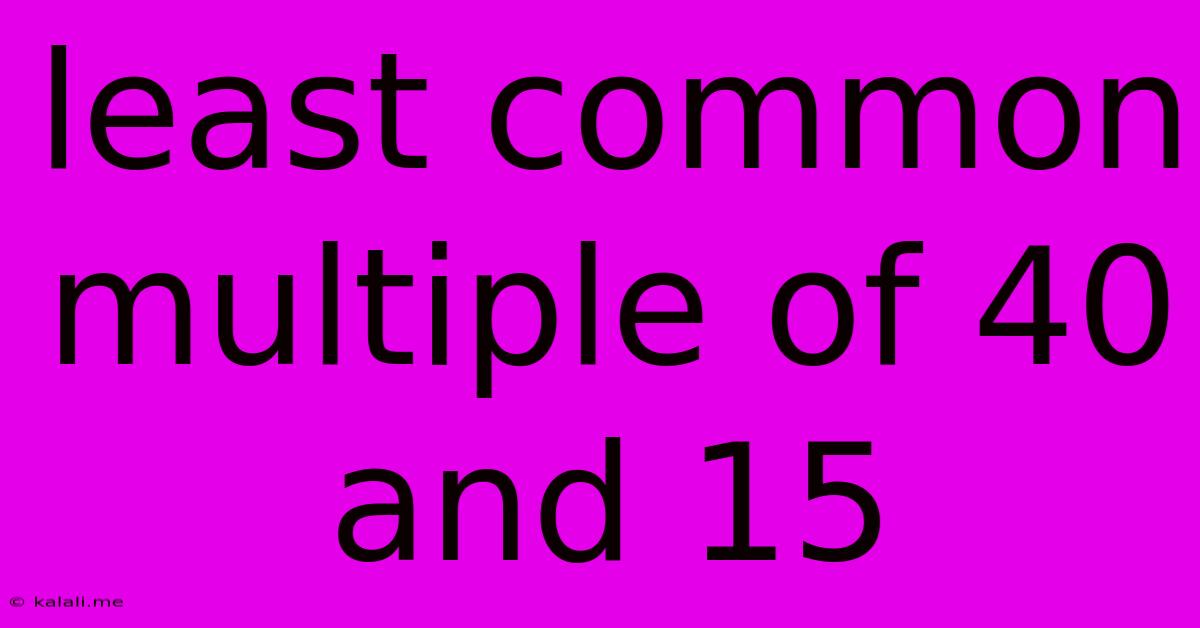Least Common Multiple Of 40 And 15
Kalali
Jun 14, 2025 · 3 min read

Table of Contents
Finding the Least Common Multiple (LCM) of 40 and 15: A Step-by-Step Guide
Finding the least common multiple (LCM) is a fundamental concept in mathematics, particularly useful in simplifying fractions and solving problems involving cycles or periodic events. This article will guide you through different methods to calculate the LCM of 40 and 15, explaining the process clearly and concisely. Understanding LCM is crucial for various mathematical applications, including algebra and number theory. This guide will equip you with the knowledge and techniques to solve similar LCM problems efficiently.
What is the Least Common Multiple (LCM)?
The least common multiple (LCM) of two or more integers is the smallest positive integer that is divisible by all the integers. In simpler terms, it's the smallest number that contains all the numbers as factors. For example, the LCM of 2 and 3 is 6, because 6 is the smallest number divisible by both 2 and 3.
Methods for Finding the LCM of 40 and 15
There are several ways to find the LCM of 40 and 15. Let's explore two common and effective methods:
1. Listing Multiples Method
This method involves listing the multiples of each number until you find the smallest multiple common to both.
- Multiples of 40: 40, 80, 120, 160, 200, 240...
- Multiples of 15: 15, 30, 45, 60, 75, 90, 105, 120, 135...
Notice that 120 appears in both lists. Therefore, the LCM of 40 and 15 is 120. This method is straightforward for smaller numbers but can become cumbersome with larger numbers.
2. Prime Factorization Method
This method is more efficient, especially for larger numbers. It involves finding the prime factorization of each number and then constructing the LCM using the highest powers of each prime factor.
- Prime factorization of 40: 2³ x 5
- Prime factorization of 15: 3 x 5
To find the LCM, we take the highest power of each prime factor present in either factorization:
- Highest power of 2: 2³ = 8
- Highest power of 3: 3¹ = 3
- Highest power of 5: 5¹ = 5
Now, multiply these highest powers together: 8 x 3 x 5 = 120. Therefore, the LCM of 40 and 15 is 120. This method is generally preferred for its efficiency and applicability to larger numbers. Understanding prime factorization is key to mastering this technique.
Applications of LCM
Understanding LCM has practical applications in various areas:
- Fraction addition and subtraction: Finding a common denominator is crucial for adding or subtracting fractions. The LCM of the denominators provides the least common denominator (LCD).
- Scheduling problems: Determining when events with different periodicities will occur simultaneously (e.g., buses arriving at a stop).
- Gear ratios and rotations: Calculating the synchronization of rotating parts in mechanical systems.
Conclusion
The least common multiple (LCM) of 40 and 15 is 120. Both the listing multiples method and the prime factorization method are valuable techniques for calculating the LCM. The prime factorization method, however, is generally more efficient and recommended for larger numbers. Mastering the concept of LCM is beneficial for various mathematical applications and problem-solving scenarios. Remember to practice these methods to solidify your understanding and improve your problem-solving skills.
Latest Posts
Latest Posts
-
What Is The Multiple Of 12
Jun 14, 2025
-
What Is The Difference Between Geology And Geography
Jun 14, 2025
-
Verbs That Start With The Letter E
Jun 14, 2025
-
Lcm Of 8 9 And 6
Jun 14, 2025
-
Which Of The Following Is Not A Copd
Jun 14, 2025
Related Post
Thank you for visiting our website which covers about Least Common Multiple Of 40 And 15 . We hope the information provided has been useful to you. Feel free to contact us if you have any questions or need further assistance. See you next time and don't miss to bookmark.